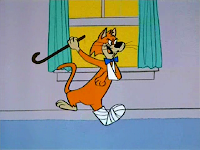Produced and Directed by Bill Hanna and Joe Barbera.
Credits: Animation – Art Davis; Layout – Paul Sommer; Background – Bob Gentle; Written by Warren Foster; Story Direction – Alex Lovy; Titles – Art Goble; Production Supervision – Howard Hanson.
Voice Cast: Insurance Agent, Pixie, Bulldog (growling only) – Don Messick; Jinks, Dixie, Evil Jinks, Bulldog – Daws Butler.
Music: Bill Loose/John Seely, Jack Shaindlin, Spencer Moore, Geordie Hormel.
Episode: Huckleberry Hound Show No. K-50.
First Aired: week of February 20, 1961.
Plot: Jinks buys an accident insurance policy for Pixie and Dixie.
It’s a story which worked really well in the Woody Woodpecker cartoon “Wet Blanket Policy.” Buzz Buzzard takes out a life insurance policy on Woody, tries to kill him to collect the insurance, only to have the aggressive Woody bash the crap out of him instead. Warren Foster tries the same sort of thing in “Jinxed Jinks.” Of course, Mr. Jinks doesn’t want to kill the meeces—he’s not that nasty, after all—he just wants them injured in an accident to collect some cash.
This cartoon also favours another well-worn routine, the appearance of an evil alter ego. Unlike a lot of cartoons, there’s no fight with a counter-balancing good alter ego. Despite the familiarity, and an ending you might be able to predict, the cartoon’s a pleasant enough 6½ minutes.
There’s nothing really outstanding in the design, layout or animation. I like how the bad Jinks is in a white outline form. And background artist Bob Gentle gives us a yellow sky and blue-green clouds.


Dialogue samples. First, when Jinks calls the meeces out of their hole:
Jinks: I gather, like, uh, you two ginks kinda, like, uh, think I’m a tyrant-like, mm?
Pixie: Well, uh, the impression...uh, there are times...uh...
Dixie: He means “yes.”
Jinks: Well, fellas, you are observing a changed Jinksie.
Pixie (
brightly): Gee, that’s wonderful!
Dixie: Yeah. Any change will be an improvement.
Jinks: I will overlook, uh, that snide-like observation, uh, because I have good news for you meeces.
Pixie: I know! You’re going away on a long trip.
Dixie: Or else you caught your tail in a ringer.
Jinks (
to the audience): I love meeces, you know, with a gift for sharp-like, uh, repartée.
Then, when Jinks realises he’s wasted an insurance premium payment, and alter ego bad Jinks appears.
Bad Jinks: It wouldn’t have to be wasted. You could speed up the inevitable.
Jinks: Yeah. I could cut down the time lag. Uh, there’s nothin’ wrong in that. It’s the temp of the times, the speed-up. Yan-kee know-how. It’s almost like, you know, patriotic.
Bad Jinks: Now you’re talking.
Yup. Maiming someone to collect cold, hard, cash is The American Way. That’s Foster’s satire for the day.
It takes about half of the cartoon to get into the violence gags. First, Jinks and the insurance agent-selling cat with Don Messick’s standard ‘growly’ voice facetiously exchange chatter over the need for a policy. (Cat: I hope nothin’ happens. But you never can tell. Jinks: Yeah, that’s right. ‘Cause, you know, the future is veiled, in a mist, like.”) Next, Jinks facetiously talks with the meeces about the policy. Then the scene with Bad Jinks as Dixie flies on top of a kite for some reason. The gags:
● Jinks throws an iron at the meeces. It misses.
● Inspired by Rube Goldberg, Jinks hooks up a trap whereby a bowling ball rolls along a plate-rail and through a hole and drops onto the meeces. Instead, when the meeces activate the trap, the bowling ball simply drops off the plate-rail, onto Jinks’ head and cracks apart.
● At the suggestion of his villainous alter ego, Jinks grabs a croquet mallet (well, this is ‘60s suburbia) and hides in the bushes to bash the meeces as they pass by. Pixie and Dixie approach with a bulldog to tell the cat “the good news.” Jinks clobbers the bulldog on the head instead. “I have pulled, like, a faux pas,” he tells us as the scene fades out.



We miss the violence which, of course, would blow Bill Hanna’s budget to animate. Instead, the camera fades in on Jinks in a hospital bed. The friendly, sincere meeces have a basket of goodies for the cat, and tell him the good news: they paid for it with the accident insurance policy they took out on Jinks. Cut to the outside door of the hospital (?) where Jinks chases them past the same light socket five times, hobbling on a leg cast, shouting “I hate you meeces to pieces” as the cartoon ends. It’s a shame Foster couldn’t fit in more gags but who knows if any were on his story board that had to be taken out.
Jinks chases Pixie and Dixie to “On the Run” at the end of the cartoon. And the George Hormel cue “Light Eerie” works well when the bad version of Jinks appears.
0:00 -
Pixie and Dixie Main Title theme (Curtin, Hanna, Barbera, Shows).
0:13 -
L-75 COMEDY UNDERSCORE (Moore) – Jinks gets insurance policy, walks.
1:08 -
C-19 LIGHT ACTIVITY (Loose) – Jinks talks to meeces, Jinks looks up at kite.
2:44 -
ZR-49 LIGHT EERIE (Hormel) – Jinks talks to Evil Jinks.
3:11 -
LAF-4-6 PIXIE PRANKS (Shaindlin) – Pixie and Dixie walk, iron, Jinks demonstrates bowling ball set-up, ball clobbers Jinks, “You’re welcome.”
4:49 -
TC-300 ECCENTRIC COMEDY (Loose-Seely) – “Excuse me fellas,” Jinks walks.
5:04 -
ZR-49 LIGHT EERIE (Hormel) – Jinks talks to Evil Jinks, Jinks with croquet mallet.
5:45 - LAF-25-3 zig zag strings and bassoon (Shaindlin) – Pixie and Dixie with bulldog, mallet clobbers dog, “faux pas.”
6:15 -
C-3 DOMESTIC CHILDREN (Loose) – Jinks in hospital bed. “You what?”
6:44 - LAF-2-12 ON THE RUN (Shaindlin) – Crashing sound, Jinks hobbles after meeces.
6:57 - Pixie and Dixie End Title theme (Curtin).


















































